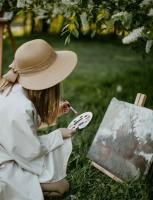Relieve anxiety with photography as a therapeutic tool
Anxiety is a set of emotional responses such as discomfort, tension and fear that is experienced before a stimulus or situation that is experienced as threatening and it can make everyday life difficult.
The presence of anxiety does not imply pathology; it is an adaptive response to events in the environment. It is considered pathological when it significantly interferes with daily life.
On the other hand, anxiety can be a trait when it appears as a natural tendency of the person to respond with a certain level of anxiety, in a stable way over time, and reflects their way of being and doing the person.
- Related article: "Types of Anxiety Disorders and their characteristics"
How is anxiety expressed?
It is understood that there is a state of anxiety when it occurs an anxious response to a specific and specific moment, being an adaptive response to the need of the situation (Allport, 1961).
On the other hand, people with an anxiety trait are usually:
- Restless
- Slopes of external stimuli.
- With a high level of activation.
- Great muscle tension.
- Difficulty disconnecting.
- They are not present.
- Sensitive to the environment.
Anxiety disorder, that misunderstood disorder
Anxiety disorder is one of the most common sets of psychological disorders in the population. It is estimated that more than 28% of the population has had an anxiety disorder in their lifetime. However, it is not always well understood by the person's environment, and the seriousness of the problem is underestimated, which can negatively affect daily life. It can cause a person to feel helpless and low self-esteem, which increases anxiety and even sadness and depression.
The anxiety crisis is reflected in the sudden appearance of numerous somatic and psychological symptoms, and a sense of imminent danger, in a short period of time.
The main somatic symptoms are:
- Tachycardia and palpitations.
- Sweating
- Feeling of suffocation
- Tightness or abdominal discomfort.
- Dizziness, chills, and hot flashes.
The psychological symptoms that may occur are:
- Daze.
- Nervousness.
- Depersonalization.
- Fear of losing control.
- Abnormal tingling sensations on the skin.
Creative therapy as an alternative in your treatment
Recent studies have shown that the effects of anxiety can be reduced through creative therapy. Photography as a therapeutic medium is a highly effective tool to relieve anxiety and its symptoms.
The history between photography and psychiatry goes back almost to the beginning of the former. Its use as a means of registration and documentation was used by psychiatrists well into the twentieth century, when discovers the potential of photography as a therapeutic medium (Cornelison, 1980) by focusing on the portrait of the patient.
In expressive psychotherapy, photographic snapshots are used as an intermediary tool between the more or less forgotten memories together with the feelings to be processed, and deepens these experiences to re-elaborate and reinterpret them psychologically (Walker, 1982). The patient becomes an active protagonist by being trained to make their own photographic images.
But it was Judy Weiser who used the photographs as an expressive vehicle in her psychotherapeutic work with deaf children, referring to this practice as "PhotoTherapy" in 1973.
The great advantage of using photography is that currently most people have a camera on their cell phones. We are used to using the camera, so it is not a barrier in its use. Unlike other expressive techniques that can generate resistance such as painting or drawing, photography carries a certain degree of security in its execution.
Change perspective
If something characterizes photography, it is the ease with which it allows you to change perspective.. From subjective reference, perspective refers to the way something looks. The perspective is taken as the relationship that exists between the objects of an image.
Thus, the subjective point of view from which the person interprets the anxiety-triggering event can be altered, and it is possible to take a new approach.
- The experience of the game through the composition and framing of the external world materialized in a photograph, makes it easier to stop perceiving it as threatening, and relaxes tensions.
- It helps to disconnect from worries, to be present and to leave circular thoughts.
To photograph the world you have to go out
Although an anxiety crisis is unexpected, normally the first appears when you are experiencing a highly stressful situation, of great emotional tension and high anxiety (Barlow, 1998).
An anxiety attack does not necessarily imply a panic disorder. Nevertheless, the anticipatory fear of suffering a new crisis can provoke avoidance behaviors such as fear of being away from home, crowded places, closed spaces such as elevators, traveling in public transport, driving, etc.
For the management of the state of anxiety, it is recommended to exercise, walk outdoors, or any activity that causes the appearance of endorphins. In this sense, photography is a motivator to go outside the home environment. Nature as a source of inspiration for photography, helps to expand the comfort zone.
Pay attention to the small details, stopping to observe the environment looking for new textures, colors and shapes encourages people to expand their comfort zone. The environment becomes less hostile, and more reliable.
How to Boost Self-Esteem with Photography to Relieve Anxiety
One way I use creative therapy to relieve anxiety is by creating simple photographs. It is suggested that the person take a photo every day as a way to connect with themselves and with the present moment.
Among the advantages of using photography to relieve anxiety are the following.
- Thoughts slow down.
- The environment is observed in a new way.
- Attention is paid to the present.
- Vitality is fostered.
- You reflect on your own perspective.
- There is a correction of distortions of certain life experiences.
- It helps to recognize moments of change in life.
A simple and very effective exercise, which I have checked in consultation, is propose a personal photography project. The project consists of representing three parts: me, me and the other, me and the world. It allows them to delve into the subjective vision of their own way of being, in the acceptance of facts, and in how they relate to interpersonal and intrapersonal phenomena.
Together with the participant, the photos taken from one session to another are observed, in order to deepen the feelings and emotions evoked by them.
As a therapist, the person is guided with questions, to help personal discovery and be more aware of some aspects of their own personality and their own way of being.
Photography is a journey of self-discovery non-invasive, it equips the person to manage their own emotional world. Photography invites you to take a moment to notice what you are feeling in the current moment.
Bibliographic references:
- Barlow, D. H. (1988). Anxiety and its disoders: The nature and treatment of anxiety and panic. New York: Guilford Press.
- Sandín, B. and Chorot, P. (2009). Concept and categorization of anxiety disorders. In Belloch, B. Sandín and F. Ramos (2009). Manual of Psychopathology (Revised Edition, Volume II). Madrid: Mc GrawHill.
- Martínez, Ó., 2016. Photography as a therapeutic instrument in mental health. Atopes. Mental health, community and culture, (17), pp.66-83.



